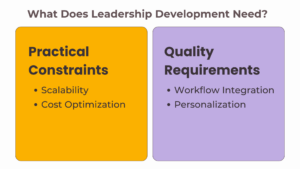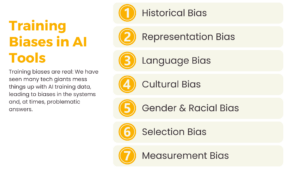Introduction
AI is predicted to be the dominant trend for Learning and Development (L&D) in the coming year. Are your teams ready? In this article, we present a framework to evaluate and implement AI for L&D in three steps:
- Preparation: Understanding AI’s capabilities beyond content generation, including language processing, pattern recognition, code generation, and creative tasks. We outline specific L&D applications for each capability.
- Implementation: This section provides a structured approach to choosing AI tools, using leadership development as an example. It includes a detailed comparison of various AI coaching platforms based on features like personalization, scalability, and cost.
- Red Flags: This section warns against common pitfalls when adopting AI tools, including overgeneralized applications, unrealistic promises of rapid transformation, surface-level impact, and training biases.
Let’s take a step toward thoughtful AI integration in L&D processes while maintaining realistic expectations is the need of the hour.
2025 is slated to be the year of AI. As per L&D’s Global Sentiment Survey,1 AI is the hot topic for this year. It shows consistent progress over the last few years, culminating in the top spot. But here’s the thing: there’s much interest in what AI can do. There is plenty of ongoing dialogue about the massive changes it is expected to bring for learning and development worldwide. And yet, many organizations struggle with fitting AI into their age-old systems and schemes.
It’s confusing and chaotic, and there’s a constant stream of emails asking L&D leaders to share their AI strategy for 2025.
Let’s help you answer all those pesky questions today in three steps. We will begin by understanding what AI can do for L&D; then, we will proceed to the implementation path that organizations can adopt and close by highlighting red flags to keep your eyes open.
Part 1: Preparing Before Making an AI Strategy for L&D
As with any new tech, AI comes with a learning curve. It will help you devise innovative applications if you learn what AI is and how it works and then approach why and how to use it with your team.
Several organizations have provided resources to get you over this step.
- Microsoft’s Free AI for Beginners Course2
- Google’s AI Essentials Certificate3
- YouTube has some great stuff, too
Before making an AI-integrated L&D strategy, the first question is: Where does AI fit into your workflow?
L&D teams essentially have two divisions in their work:
- The internal processes of the team itself
- The people facing bits, the outputs they create like courses
For many businesses, the answer to the AI question starts and ends with generating content, thanks to the omniscience of Generative AI tools and LLMs that produce content at the drop of a hat. But limiting yourself to that would be a disservice. It would also be a sign of the inability to leverage AI effectively.
If we were to sum up the capabilities of AI that hold relevance for L&D teams today, we have a host of features:
- Language understanding and generation, including translation, summarization, and detailed writing
- Code generation and debugging across many programming languages
- Pattern recognition in data, including images, text, and numbers
- Playing games and solving puzzles with well-defined rules
- Mathematical calculations and logical reasoning
- Document analysis and extraction of structured information
- Creative tasks like writing, image generation, and music composition
The first point is where we get stuck. But let’s explore beyond that for a change.
What can AI do for L&D teams today?
AI capability → Applications for L&D
| AI capability → Applications for L&D | |
| Language understanding and generation, including translation, summarization, and detailed writing | ● Automated generation of training materials and course content ● Creating personalized learning paths based on employee skill levels and goals ● Translating training materials into multiple languages for global teams ● Summarizing complex documents into digestible learning materials ● Drafting clear learning objectives and assessment criteria ● Generating practice scenarios and case studies ● Creating AI coaches to scale personalized support of employees |
| Pattern recognition in data, including images, text, and numbers | ● Analyzing learning metrics to identify trends in employee development ● Spotting skill gaps across departments or teams ● Identifying which training methods are most effective for different learning styles ● Tracking patterns in assessment results to improve course effectiveness ● Recognizing common areas where learners struggle or excel |
| Code generation and debugging across many programming languages
|
● Creating interactive learning modules and quizzes ● Developing simple training simulations ● Building custom LMS features ● Automating routine L&D administrative tasks ● Generating code examples for technical training |
| Document analysis and extraction of structured information | ● Extracting key information from industry reports to update training content ● Analyzing feedback forms and course evaluations ● Processing employee performance reviews to identify training needs ● Organizing and categorizing existing training materials ● Converting legacy training documents into modern formats |
| Mathematical calculations and logical reasoning | ● Calculating ROI on training initiatives ● Analyzing training effectiveness metrics ● Creating adaptive assessment algorithms ● Optimizing training schedules and resource allocation ● Developing logical progression paths for skill development |
| Playing games and solving puzzles with well-defined rules | ● Creating structured learning games with clear objectives and progression rules ● Developing branching scenarios where learners make decisions based on set criteria ● Creating simulation games for process training (like customer service scenarios) ● Creating adaptive assessments that adjust difficulty based on performance rules ● Building diagnostic tools to assess skill levels through game-like challenges |
| Creative tasks like writing, image generation, and music composition | ● Designing engaging presentation materials ● Creating scenario-based learning exercises ● Developing storytelling elements for training modules ● Generating varied examples and practice problems ● Writing clear and engaging assessment questions |
Table 1. Applications of AI across various L&D functions.
How much of this are you doing or planning to do soon?
Part 2: Getting Started with AI in L&D
Based on the applications of AI we saw above, let’s use an example to understand how to choose the right tools.
We noted that AI tools can deliver personalized learning experiences at scale, thus meeting the needs of leaders who need coaches. This guided assistance is also valuable because the usual cost of leadership training and coaching is quite prohibitive, so AI promises us an opportunity to reach more people.
So now, the question is: How do we choose the right AI platform or program for leadership development?
We’ll go about this in a structured process:
- Define your needs/goals: As we pick a leadership development tool, consider what’s missing. Leadership development opportunities don’t reach all the managers in your organization, so scalability is one. Leadership development also needs to be available at the point of need, so availability in the flow of work is another feature we will look for. Third, since we are building at scale, we want to optimize for cost, or getting budget approvals will be difficult. Last, let’s consider that we have a distributed team and need coaches who can personalize as per job roles, languages, level of expertise, and other factors for multiple users.
 Image 1. Key Goals of Leadership Development Solutions.
Image 1. Key Goals of Leadership Development Solutions.
- Define your audience: Next, you need to answer two questions. First, who is your audience? Second, how big is your audience? For example, we can consider a leadership development program focused on new managers who have taken up their roles without much training to support them through the transition.
- Prioritize your needs: What matters the most to your organization? You will need coaches who can work with multiple languages if you have a global team. If your team faces challenges like high turnover or minimal availability for training, you need focused goal-setting, nudges, and on-the-job support. Depending on your context, prioritize the features multiple AI tools offer from most to least important.
For example, for the AI-powered leadership development tools that we are examining, we can draw this arrangement:
| Tools | Risely | CoachHub | Marlee | Bunch AI | Rypple AI |
| Coaching Features | |||||
| Personalization | ✔ | ✔ | ✔ | ✔ | ✔ |
| Scalability | ✔ | ✔ | ✔ | ✔ | ✔ |
| Scenario-based Practice | ✔ | ✔ | ✔ | ||
| On-demand Coaching | ✔ | ✔ | ✔ | ✔ | ✔ |
| Truly AI Coaching | ✔ AI coaching with Merlin |
✔ AI coaching with Aimy |
✔ AI coaching with Marlee |
✔ AI coaching with Bunchee |
✔ AI coaching with Rypple |
| Voice Mode | ✔ | ✔ | ✔ | ||
| Continuous Learning Features | |||||
| Microlearning Nudges | ✔ | ✔ | ✔ | ||
| Multi-lingual Support | ✔ 40+ languages in AI coach |
✔ | |||
| Skill Assessments | ✔ 30+ Core & Advanced People Skills |
✔ Pre and Post Growth Assessments |
|||
| Feedback and Reports | ✔ | ✔ | ✔ | ✔ | |
| Enterprise Features | |||||
| Collaboration with Team | ✔ | ✔ | |||
| Optimizing for Company Culture | ✔ | ||||
| Ingesting Existing Learning Content | ✔ | ||||
| Goal-setting Support | ✔ | ✔ | |||
| Workspace Integrations | ✔
Slack & MS Teams |
||||
Table 2. Comparing AI Leadership Development Tools.
- Consider constraints: There will be questions and critiques when adding an AI tool to your armory. Remember, we began this article by learning about AI. The same thing needs to be done with your team so that they can understand what this tech is and where it fits into the greater scheme of things. Similarly, while applying AI tools for leaders, we must ensure they have the proper devices and know-how to use an AI coach easily. If you feel there is some skepticism or concerns in your team, it’s time for an all-hands deep dive into how the future of work is shaping up. Your people skills will be helpful as we build the next generation of L&D leaders.
- Weigh all the alternatives to pick the best: The last and final step is to weigh your options using the benefits they can bring and the costs you would have to pay. Consider heading back to the priorities you set earlier and give more weight to the features that matter to you and your team. At this point, it is vital to remember that L&D needs to impact business objectives to earn a seat at the table with the C-suite. So, pick the right tool that will support you in modernizing the function and hitting milestones.
Part 3: Red Flags in AI Tools to Keep an Eye on
But all that glitters is not gold; sometimes, the skeptics might be right, too! Remember that AI is a novel tech; users and builders also experiment. That’s why we will look into the significant signs of trouble you should avoid while picking up an AI tool for your organization.
Overgeneralized applications of AI: It’s the era of AI for sure. But more precisely, it’s the era of vertical AI applications that go into specific use cases rather than being the jacks of all trades. When AI tools are applied to an extensive range of problems, their ability to provide specificity and support in niche applications suffers. Hence, look for AI tools designed specifically for your use cases; they would be better trained in the appropriate context and built with your constraints in mind.
Promises of sudden growth: AI looks like a magic wand but cannot transform your people in a single day. Applying AI to your workflows is a gradual process that starts with something as simple as using Gemini to automate something before committing to tools and plans. Your AI strategy needs to consider your organization’s level of maturity and avoid jumping on the hype train.
Surface level impact: Is AI working for you? You must answer that question multiple times once you are in the cycle with inquiries from your stakeholders, users, peers, and other observers. The key is to keep an eye on the actual impact by not letting go of measurement and tracking in your L&D systems. Many AI apps will show you things being done with fancy jargon and changing names to appear personalized. Learn how to differentiate from this and identify the real gold nuggets.
Training biases are real: We have seen many tech giants mess things up with AI training data, leading to biases in the systems and, at times, problematic answers. L&D functions are impactful for the whole organization. Thus, you need to carefully vet and test AI tools before getting into full swing. Consider taking demos with multiple tools, ask vendors about the training process and what they have done to remove biases, and use trial periods heavily before choosing the best one for your organization.
 Image 2. Common Biases in AI’s Training Data.
Image 2. Common Biases in AI’s Training Data.
Ultimately, we are moving toward an AI-powered future. As custodians of organizational growth, L&D leaders are uniquely positioned to lead this movement and inspire others to follow suit. Your organization’s identity as an AI-powered team hinges on these choices.
To Sum Up
We must prepare to face new challenges as we approach a new year. L&D teams are on a tightrope amid uncertain economic and social circumstances coupled with the advent of AI in full swing.
As leaders of L&D teams, you can effectively empower your workplace by leveraging AI. The key is understanding how AI works and implementing it smartly in your organization without falling prey to the hype brigade. Using workplace-based AI raises several ethical questions and conversations about the future of work that require consideration. Thus, an informed and thoughtful praxis is the need of the hour.
Endnotes
1 Donald H Taylor, 2024 L&D Global Sentiment Survey. https://donaldhtaylor.co.uk/research_base/global-sentiment-survey-2024/
2 Artificial Intelligence for Beginners – A Curriculum https://microsoft.github.io/AI-For-Beginners/
3 Google AI Essentials https://grow.google/ai-essentials/
